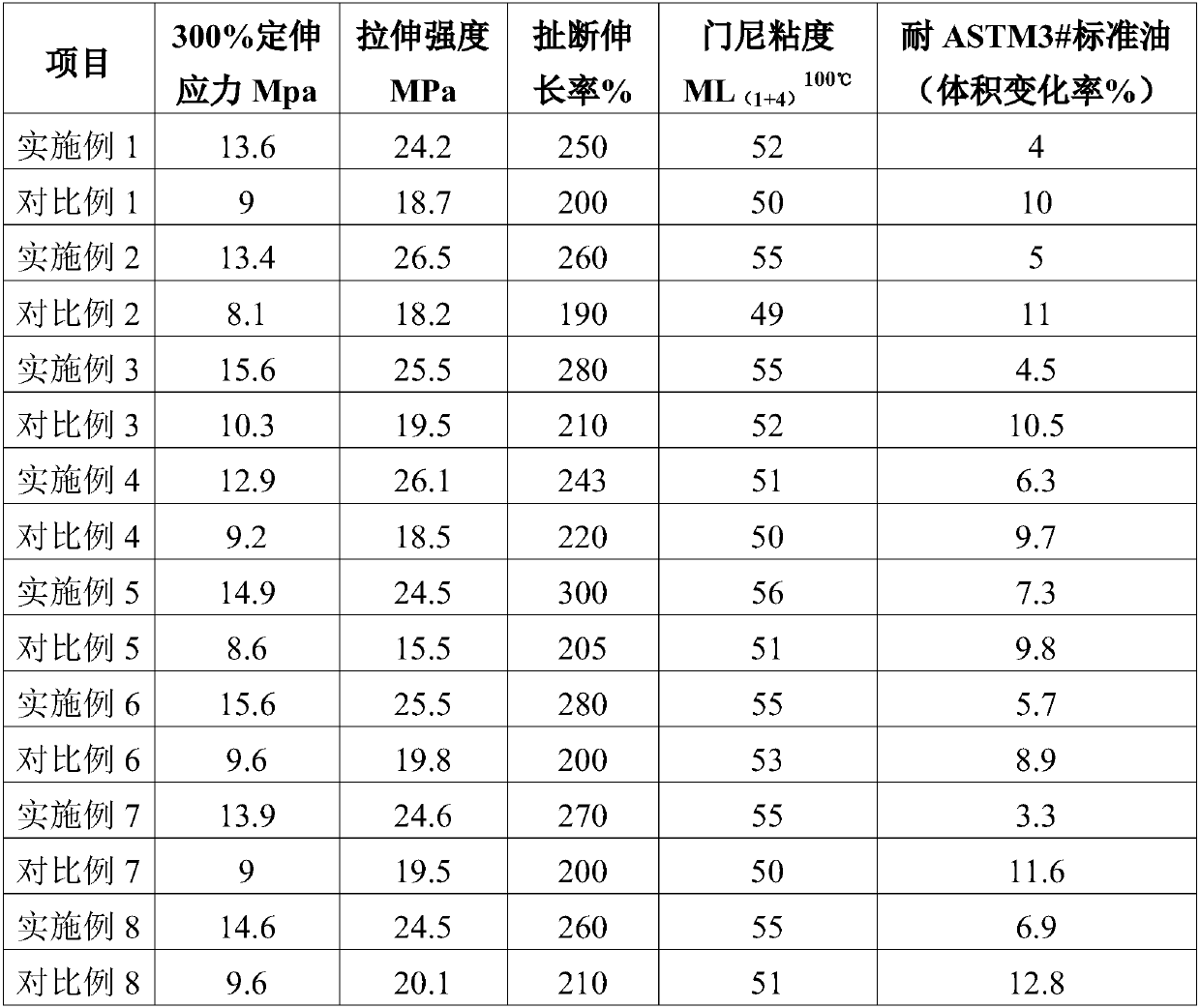Brominated isobutylene/alkyl styrene polymer and nitrile rubber composite material and preparation method thereof
A technology of brominated isobutylene and alkyl styrene, which is applied in the field of oil-resistant composite materials and its preparation, can solve problems such as cold resistance decline, and achieve the effects of convenient vulcanization, reinforced oil resistance, excellent mechanical properties and oil resistance
- Summary
- Abstract
- Description
- Claims
- Application Information
AI Technical Summary
Problems solved by technology
Method used
Image
Examples
Embodiment 1
[0024] Brominated isobutylene / o-methylstyrene polymer and nitrile rubber composite material: the temperature of the open mill is raised to 80°C, the roll distance is adjusted to 1mm, 20 parts of brominated isobutylene / o-methylstyrene polymer, nitrile Add 80 parts of rubber, 8 parts of dioctyl phthalate, and 50 parts of carbon black N550. After the rubber material is covered with rolls, adjust the temperature to 70°C, and then add 4 parts of polytetrafluoroethylene and 3 parts of zinc stearate. , 2 parts of zinc oxide, 3 parts of sulfur, 1 part of accelerator TETD, 2 parts of accelerator CZ, 3 times each for left and right 3 / 4 knives, adjust the roller distance to 0.5mm, knead for 5min, and thin pass 5 times for the next sheet to be mixed. The material is kneaded, and then vulcanized for 40 minutes under the vulcanization conditions of 150 ° C and 9 MPa to obtain the composite material of isobutylene / o-methyl styrene polymer and nitrile rubber.
Embodiment 2
[0028] Brominated isobutylene / m-methylstyrene polymer and nitrile rubber composite material: the temperature of the open mill is raised to 90°C, the roll distance is adjusted to 1mm, 30 parts of brominated isobutylene / m-methylstyrene polymer, nitrile Add 70 parts of rubber, 6 parts of dioctyl phthalate, and 60 parts of carbon black N550. After the rubber material is covered with rolls, adjust the temperature to 70°C, and then add 5 parts of polytetrafluoroethylene and 3 parts of zinc stearate. , 2 parts of zinc oxide, 4 parts of sulfur, 2 parts of accelerator TETD, 1 part of accelerator CZ, 3 times each for left and right 3 / 4 knives, adjust the roller distance to 0.5mm, knead for 6 minutes, and thin pass 5 times for the next sheet to be kneaded The material is vulcanized for 30 minutes under the vulcanization conditions of 160°C and 15MPa to obtain the composite material of isobutylene / m-methylstyrene polymer and nitrile rubber.
Embodiment 3
[0032]Brominated isobutylene / p-methylstyrene polymer and nitrile rubber composite material: the temperature of the open mill is raised to 90°C, the roll distance is adjusted to 1mm, 30 parts of brominated isobutylene / p-methylstyrene polymer, nitrile Add 70 parts of rubber, 5 parts of dioctyl phthalate, and 65 parts of carbon black N550. After the rubber material is rolled, adjust the temperature to 75°C, and then add 6 parts of polytetrafluoroethylene and 3 parts of zinc stearate. , 2 parts of zinc oxide, 5 parts of sulfur, 1 part of accelerator TETD, 3 parts of accelerator CZ, 3 times each for left and right 3 / 4 knives, adjust the roller distance to 0.5mm, knead for 8 minutes, thin pass 5 times and lower the tablet to get the mixture The material is kneaded, and then vulcanized under the vulcanization conditions of 170°C and 12MPa for 30min to obtain the composite material of isobutylene / p-methylstyrene polymer and nitrile rubber.
PUM
 Login to View More
Login to View More Abstract
Description
Claims
Application Information
 Login to View More
Login to View More - Generate Ideas
- Intellectual Property
- Life Sciences
- Materials
- Tech Scout
- Unparalleled Data Quality
- Higher Quality Content
- 60% Fewer Hallucinations
Browse by: Latest US Patents, China's latest patents, Technical Efficacy Thesaurus, Application Domain, Technology Topic, Popular Technical Reports.
© 2025 PatSnap. All rights reserved.Legal|Privacy policy|Modern Slavery Act Transparency Statement|Sitemap|About US| Contact US: help@patsnap.com

